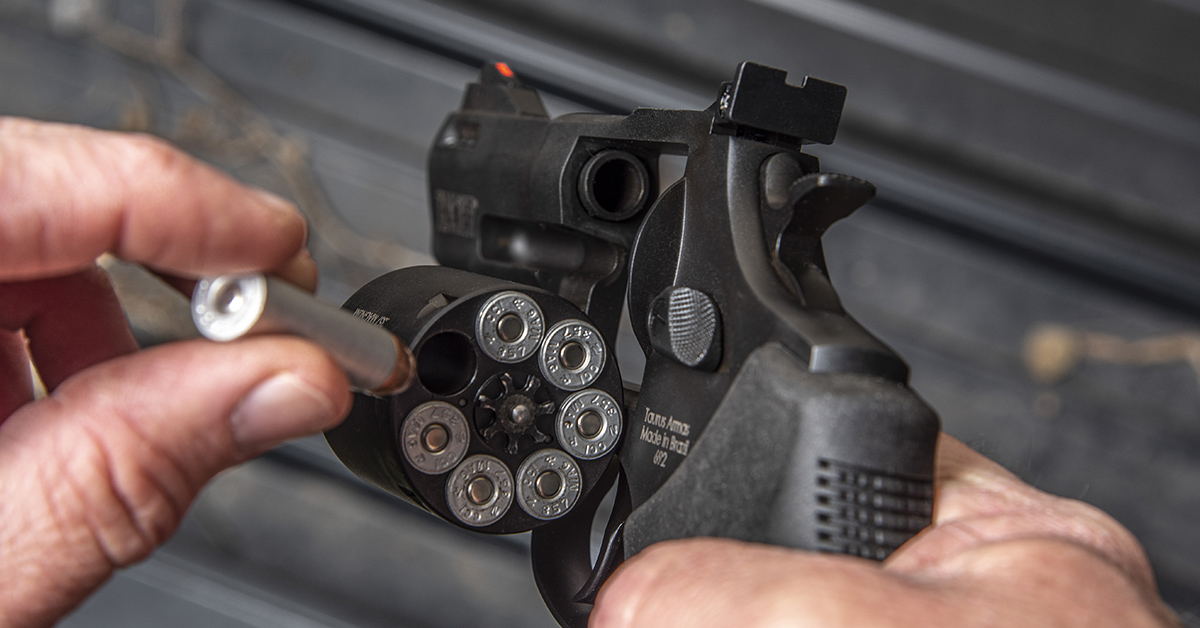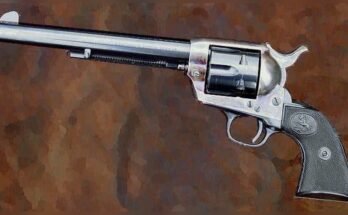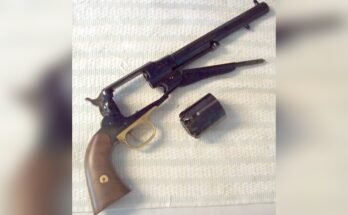If you own a swing-out cylinder revolver, knowing how to reload it quickly and safely can make all the difference. Whether you’re at the range or in a critical situation, mastering this skill gives you confidence and control.
You’ll discover simple, step-by-step instructions to reload your revolver with ease. Ready to improve your handling and speed? Keep reading to unlock the secrets that every revolver owner should know.
Types Of Swing-out Cylinder Revolvers
Swing-out cylinder revolvers come in different types. Each type works a bit differently. Knowing these types helps in handling and reloading them safely and quickly.
Two main types of swing-out cylinder revolvers are single-action and double-action. Each has its own mechanism and feel.
Single-action Vs Double-action
Single-action revolvers require you to pull the hammer back before each shot. This action also cocks the gun. The trigger then only releases the hammer to fire.
Double-action revolvers allow you to pull the trigger to both cock and release the hammer. This makes firing faster but can make the trigger pull heavier.
Reloading both types is similar because the cylinder swings out to the side. You can then eject spent cartridges and load new ones.
Common Models
Many popular models use swing-out cylinders. The Smith & Wesson Model 686 is a well-known double-action revolver. It is reliable and easy to reload.
The Colt Python is another famous double-action model. It is prized for its smooth trigger and accuracy.
For single-action, the Ruger Vaquero is a classic choice. It has a traditional look and a strong frame.
These models showcase the variety and style of swing-out cylinder revolvers. Each offers a unique shooting experience and reloading method.
Safety Precautions Before Reloading
Always keep the revolver pointed in a safe direction before reloading. Make sure the gun is unloaded and your hands are dry. Check the cylinder carefully to avoid accidents.
Check The Firearm Condition
Always start by inspecting your revolver’s condition. Make sure it is clean and dry. Check for any signs of damage or rust. A well-maintained firearm works better and safer. Never reload a weapon that looks damaged or faulty.
Hold the revolver firmly but carefully. Keep your finger off the trigger at all times. This reduces the chance of accidental firing. Treat every firearm as if it is loaded, even if you think it is not.
Clear The Cylinder
Open the swing-out cylinder fully to inspect it. Look inside each chamber to see if it is empty. Push out any spent casings with the ejector rod. Confirm no live rounds remain before adding new cartridges.
Clearing the cylinder prevents accidental firing and jams. It also ensures smooth reloading. Take your time and do not rush this step. Safety depends on careful and thorough checking.
Opening The Cylinder
Opening the cylinder on a swing-out cylinder revolver is the first step in reloading. It allows you to remove spent cartridges and load fresh rounds quickly. Knowing how to open the cylinder safely and correctly helps avoid damage and keeps the process smooth.
Locate The Release Mechanism
Look for a small lever or button near the cylinder. This is the release mechanism. Most revolvers have it on the left side, just behind the cylinder. Press or push this lever firmly. This action unlocks the cylinder from the frame.
Do not force it. The mechanism should move easily if you apply steady pressure. Understanding this part is key to handling your revolver safely and efficiently.
Swinging Out The Cylinder
After unlocking, gently push the cylinder outward. It swings out to the side of the revolver. Use your fingers to guide it smoothly. Avoid sudden or harsh movements to prevent damage.
The cylinder should stop in an open position, allowing access to all chambers. Now, you can eject empty casings and reload new cartridges. Practice this step to gain confidence and speed.

Ejecting Spent Cartridges
Ejecting spent cartridges is a key step in reloading a swing-out cylinder revolver. It clears the empty shells, making space for fresh rounds. Proper ejection ensures the revolver functions smoothly and safely during use.
Most revolvers have an ejector rod that helps push out the spent cartridges. This rod lines up with each chamber and releases the shells with a simple push. Understanding how to use the ejector rod correctly saves time and effort.
Using The Ejector Rod
Hold the revolver firmly with the cylinder open. Grasp the ejector rod, usually located under the barrel. Push the rod carefully toward the back of the cylinder. This action forces the spent cartridges out of their chambers. Apply steady pressure until all shells start to move.
Be gentle to avoid damaging the revolver. Avoid hitting the ejector rod with excessive force. The rod should slide smoothly and eject the shells easily. Check that no cartridges remain stuck inside the cylinder.
Clearing All Chambers
Rotate the cylinder slowly while keeping the ejector rod pushed. This movement helps clear every chamber completely. Inspect each chamber to confirm it is empty. Use your fingers if needed to remove any stuck shells. Clean chambers allow for quick and safe reloading.
Always double-check the cylinder before loading new cartridges. This prevents jams and ensures the revolver works properly. A clean, empty cylinder improves shooting accuracy and safety.
Loading New Ammunition
Loading new ammunition into a swing-out cylinder revolver is a simple step after opening the cylinder. This process ensures your revolver is ready to use and safe to handle. Careful attention to each step keeps the gun working properly and prevents jams or misfires.
Choosing The Right Cartridges
Select cartridges that match your revolver’s caliber exactly. Using the wrong size can cause damage or unsafe conditions. Check the barrel or frame markings to find the correct caliber. Buy quality ammunition from trusted sources. Avoid old or damaged rounds as they may fail to fire or cause problems.
Inserting Rounds Properly
Hold the cylinder steady after swinging it out. Place each cartridge into the chamber with the bullet facing forward. Push the round fully into the chamber to ensure it seats correctly. Repeat for all chambers, filling each one with a cartridge. Close the cylinder gently but firmly until it locks in place.

Closing The Cylinder
Closing the cylinder on a swing-out revolver is a crucial step after reloading. It ensures the firearm is ready to use safely and effectively. Proper closing helps avoid damage to the cylinder and gun frame. It also keeps the rounds secure inside the chambers. Let’s break down the process into clear, easy steps.
Aligning The Cylinder
First, gently push the cylinder back toward the frame. Make sure the chambers line up with the barrel. This alignment is key for the revolver to function properly. Avoid forcing the cylinder as it can cause misalignment. A smooth, steady movement works best here. Check that the cylinder rotates freely without resistance before closing fully.
Securing The Cylinder In Place
Once aligned, push the cylinder firmly until it clicks into place. This click means the cylinder latch has locked it. A secure cylinder prevents the rounds from falling out. It also keeps the revolver safe to carry and use. Avoid slamming the cylinder shut to protect the firearm parts. Close the cylinder with controlled pressure to ensure safety and functionality.
Final Safety Checks
Final safety checks are crucial after reloading a swing-out cylinder revolver. They ensure the firearm works correctly and safely. These checks reduce the risk of malfunctions or accidents. Take your time and perform each step carefully.
Ensuring Proper Lockup
Check the cylinder lockup by gently closing the cylinder. It should snap into place firmly without any wobble. A loose cylinder can cause misfires or damage. Make sure the cylinder aligns perfectly with the barrel. This ensures the bullet travels straight when fired.
Testing The Trigger
Pull the trigger slowly to test its function. It should move smoothly without sticking or resistance. The hammer should cock back and release properly. This test confirms the revolver is ready to fire safely. Never point the revolver at anything you do not intend to shoot during this step.

Frequently Asked Questions
How Do You Open A Swing-out Cylinder Revolver?
To open a swing-out cylinder revolver, push the cylinder release latch. Then, swing the cylinder out to the side. This exposes the chambers for unloading or reloading rounds easily and safely.
What Is The Best Way To Reload A Swing-out Cylinder?
After opening the cylinder, eject spent casings using the ejector rod. Then, insert fresh cartridges into each chamber. Close the cylinder firmly until it locks in place before firing.
How Long Does It Take To Reload A Swing-out Cylinder Revolver?
Reloading a swing-out cylinder revolver typically takes 5 to 10 seconds with practice. Speed depends on familiarity with the firearm and quality of the cartridges used.
Can You Reload A Revolver Without Opening The Cylinder?
No, you must open the cylinder to reload a swing-out cylinder revolver. This allows safe removal of spent shells and insertion of fresh rounds.
Conclusion
Reloading a swing-out cylinder revolver is simple with practice. Open the cylinder fully to eject spent cartridges. Insert fresh rounds carefully into each chamber. Close the cylinder firmly to secure it. Always handle the revolver safely and keep your focus.
Regular practice helps you reload quickly and confidently. This skill improves your shooting experience and safety. Keep your firearm clean and well-maintained for best results. Now, you can reload your revolver smoothly every time.



